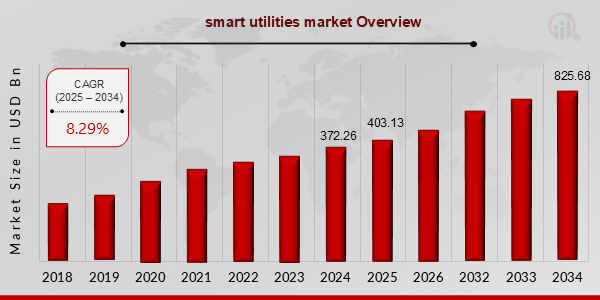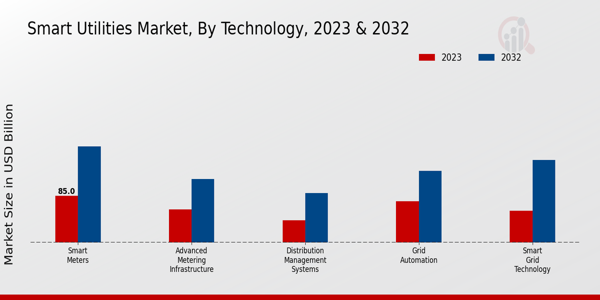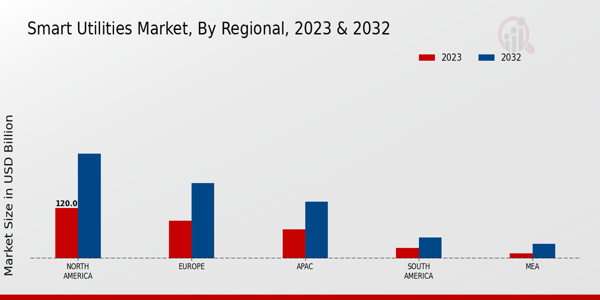Smart Utilities Market Overview
smart utilities market is projected to grow from USD 403.13 Billion in 2025 to USD 825.68 Billion by 2034, exhibiting a compound annual growth rate (CAGR) of 8.29% during the forecast period (2025 - 2034). Additionally, the market size for smart utilities market was valued at USD 372.26 billion in 2024.
Key Smart Utilities Market Trends Highlighted
The Smart Utilities Market is witnessing significant growth driven by several key market drivers. The increasing need for efficient energy management is integrating advanced technologies such as smart meters and grid management systems that enhance operational efficiency. Additionally, rising demand for renewable energy sources is pushing utilities to adopt smarter solutions that can accommodate renewable integration. The emphasis on sustainability is also fostering the growth of smart utilities as consumers and regulations demand cleaner energy production and a reduction in carbon footprints.
The digital transformation within the utility sector is enabling a shift towards advanced data analytics, ensuring better decision-making in resource allocation and distribution.Opportunities in this market are expanding as utilities look to improve customer engagement through personalized services and real-time data access. The integration of Internet of Things (IoT) technologies and artificial intelligence (AI) offers a pathway for enhanced predictive maintenance and troubleshooting, which can reduce operational costs. Moreover, there is a growing focus on cybersecurity measures as utilities become more vulnerable to cyber threats.
Exploring these opportunities can lead to innovative solutions that meet consumer needs while ensuring the security and reliability of utility services. Recent trends indicate that the market is embracing a shift toward automation and smart grid technologies, reflecting a broader move toward digitalization in the sector.More utilities are investing in smart grid initiatives that enhance connectivity and communication between consumers and energy providers. Advances in battery storage technology are also becoming central, allowing for better energy management and utilization of renewable sources.
As society increasingly values sustainability, the alignment of smart utility solutions with environmental goals complements the overall direction of the market, making it an essential area for future growth.
Figure 1 smart utilities market Overview (2025-2034)

Source: Primary Research, Secondary Research, Market Research Future Database and Analyst Review
Smart Utilities Market Drivers
Increasing Demand for Energy Efficiency
The Smart Utilities Market Industry has continued experiencing vigorous growth, fueled by the growing need for efficient energy solutions. As global energy consumption levels rise and the necessity for a reasonable energy supply increases, it is necessary for the utilities to improve their operational effectiveness and minimize energy losses. Smart utilities utilize smart meters, IoT devices, and data analytics to measure and control energy usage at all times.
This modification enables the utilities to control their operational cost but enables the consumers to control the amount of energy they utilize. Please note that many energy efficiency programs are being developed as a result of different governmental policies and incentives focused towards carbon economy reduction through better energy efficiency practices – which certainly have a growing importance. Hence, the increasing focus on energy efficiency solutions will significantly increase the demand for smart utility solutions and hence, drive the growth of the Smart Utilities Market Industry in the foreseeable near future.
Technological Advancements in Smart Grid Infrastructure
Technological advancements play a pivotal role in the expansion of the Smart Utilities Market Industry. The evolution of smart grid technology has led to the development of more resilient, efficient, and sustainable utility infrastructures. Innovations in fields such as renewable energy integration, energy storage, and advanced metering infrastructure are enabling utilities to better manage energy distribution and consumption.
These advancements not only enhance the reliability of energy supply but also facilitate the seamless integration of renewable energy sources, which is a priority for many countries looking to transition to greener energy solutions.As these technologies continue to evolve, utilities are increasingly adopting smart grid practices, bolstering the growth of the market.
Government Policies and Regulations Supporting Smart Utilities
Government policies and regulations increasingly support the shift towards smart utilities, acting as a crucial driver for growth within the Smart Utilities Market Industry. Many governments worldwide are introducing incentives, funding programs, and legislation aimed at promoting the adoption of smart utility technologies. These initiatives not only aim to enhance energy efficiency but also encourage the development of renewable energy sources and carbon-neutral strategies.The enforcement of stricter environmental regulations is leading utilities to invest in smart technology solutions to ensure compliance while optimizing their operations.
The proactive stance taken by governments in promoting smart utility frameworks is expected to spur market growth in the foreseeable future.
Smart Utilities Market Segment Insights
Smart Utilities Market Technology Insights
The Smart Utilities Market is experiencing remarkable growth, particularly within the Technology segment, which plays a crucial role in shaping the future of utility services. In 2023, this segment had a substantial valuation of 317.43 USD Billion, reflecting the significant investments in smart technologies that enhance operational efficiency and customer engagement. Key components of this segment include Smart Meters, Advanced Metering Infrastructure, Distribution Management Systems, Grid Automation, and Smart Grid Technology, all of which contribute to improved energy management and service delivery.
Smart Meters, valued at 85.0 USD Billion in 2023, are pivotal as they enable accurate real-time energy consumption data to both utilities and customers, facilitating better energy usage decisions and cost savings.Advanced Metering Infrastructure, with a valuation of 60.0 USD Billion, supports Smart Meters by providing a robust framework for communication and data management, thus enhancing overall service reliability and operational efficiency. Meanwhile, Distribution Management Systems, valued at 40.0 USD Billion, are essential for optimizing the electrical distribution network, ensuring the stability of energy supply, and reducing outages.
Grid Automation, valued at 75.0 USD Billion, stands out in the market due to its capability to improve grid reliability and operational performance, making it a vital component in modernizing the electrical grid. Finally, Smart Grid Technology is critical in facilitating the integration of renewable energy sources and electric vehicles, with a valuation of 57.43 USD Billion in 2023. This technology empowers utilities to manage the complex energy landscape effectively, respond to fluctuations in demand, and enhance grid resiliency.
Each of these elements reflects the ongoing trends and growth drivers in the Smart Utilities Market, such as increased energy efficiency, reduced operational costs, and enhanced customer engagement, while also addressing challenges like infrastructure upgrades and technological integration. The synergy between these technologies is vital for the transformation of utility management, offering numerous opportunities for market participants looking to capitalize on the smart utilities trend.
Figure 2 smart utilities market Technology Insights (2023-2032)

Source: Primary Research, Secondary Research, Market Research Future Database and Analyst Review
Smart Utilities Market Utility Type Insights
The Smart Utilities Market is experiencing a significant transformation, with a projected value of 317.43 billion USD in 2023. This market encompasses various utility types, among which Electric Utilities, Water Utilities, and Gas Utilities play vital roles. Electric Utilities dominate the market due to the increasing demand for efficient energy management systems and renewable energy integration, driving substantial investment in advanced metering infrastructure.
Water Utilities are gaining traction as smart water management technologies improve resource conservation and reduce operational costs, addressing global water scarcity challenges.Gas Utilities are also evolving, focusing on smart gas meters and leak detection systems, enhancing safety and operational efficiency. The combination of these factors contributes to a dynamic landscape where market growth is propelled by technological advancements and sustainability initiatives. As the Smart Utilities Market data evolves, significant opportunities arise in implementing IoT and data analytics to optimize utility management and enhance customer engagement, thus reshaping the industry.
Smart Utilities Market Application Insights
The Smart Utilities Market, valued at approximately 317.43 USD Billion in 2023, encompasses various applications critical for optimizing utility operations. Among these, Demand Response plays a pivotal role by enabling utilities to manage energy consumption during peak times, enhancing grid stability. Energy Management applications are also significant, focusing on the continuous improvement of energy efficiency across utility infrastructures. Infrastructure Management is essential for maintaining and upgrading utility networks, ensuring reliable service delivery.Consumer Engagement is gaining traction as it fosters better communication between utilities and customers, promoting energy-saving practices.
This segment showcases major trends in automation and digitalization, driven by the growing emphasis on sustainability and carbon reduction initiatives. Overall, the Smart Utilities Market revenue is shaped by these applications, collectively addressing the industry's need for modernization and efficiency. The segmentation within the market highlights various growth drivers, such as regulatory support and technological advancements, while addressing challenges, including the need for substantial investment and cybersecurity concerns.The Smart Utilities Market data illustrates a robust trajectory, with substantial opportunities for innovation across these application areas, making them vital for future growth in the industry.
Smart Utilities Market End User Insights
The Smart Utilities Market generated a revenue of 317.43 billion USD in 2023, demonstrating significant growth potential across various end-user segments, notably Residential, Commercial, and Industrial. The Residential sector plays a crucial role, as consumers increasingly seek energy-efficient solutions and smart home technologies, enhancing overall utility efficiency. The Commercial segment also exhibits considerable demand, driven by the necessity for cost-effective energy management solutions and sustainability practices among businesses. Meanwhile, the Industrial segment dominates the market, with industries adopting advanced energy management systems and IoT technologies to optimize operational efficiency and reduce costs.
With the expected expansion of the Smart Utilities Market and evolving consumer preferences, market participants are presented with diverse opportunities for innovation and growth. The market landscape shows promising trends indicating significant investments in smart infrastructure, sustained demand for utility automation, and evolving policies encouraging sustainable energy solutions.Overall, the Smart Utilities Market segmentation highlights a dynamic environment influenced by technological advancements and shifting power consumption patterns.
Smart Utilities Market Regional Insights
The Smart Utilities Market is experiencing significant growth across various regions, contributing to an overall market valuation of 317.43 USD Billion in 2023. In North America, the market is valued at 120.0 USD Billion, making it a major player, as this region anticipates fostering innovation and adoption of smart technologies. Europe follows closely with a market valuation of 90.0 USD Billion, benefiting from strong regulatory support for sustainable utilities. The APAC region, valued at 70.0 USD Billion, is significant due to rapid urbanization and increasing energy demand, emphasizing the region's pivotal role in the market growth.
South America, with a market value of 25.0 USD Billion, is gradually emerging as an important region thanks to government initiatives promoting energy efficiency. Meanwhile, the Middle East and Africa (MEA) holds a smaller valuation of 12.43 USD Billion, but still presents opportunities for growth as infrastructure is developed. Overall, the market segmentation within the Smart Utilities Market highlights strong regional dynamics, each with distinct factors driving growth and opportunities for innovation.
Figure 3 smart utilities market Regional Insights (2023-2032)

Source: Primary Research, Secondary Research, Market Research Future Database and Analyst Review
Smart Utilities Market Key Players and Competitive Insights
The Smart Utilities Market is experiencing rapid growth fueled by advancements in technology, increasing demand for energy efficiency and sustainability, as well as the rising necessity for smart grid solutions. The competitive landscape of this market is shaped by various factors, including increasing investments in smart technology infrastructure, regulatory frameworks promoting clean energy, and the continuous evolution of digital solutions. Organizations are striving to enhance their service delivery capabilities, optimize resource management, and improve customer engagement through advanced analytics and Internet of Things (IoT) solutions.
Furthermore, key players are focusing on partnerships, mergers, and acquisitions to expand their market presence and technological prowess, which adds to the competitive dynamics in this ever-evolving field.IBM stands out in the Smart Utilities Market due to its strong emphasis on delivering innovative technology solutions that cater to various utility sectors. The company possesses a remarkable portfolio that includes effective data management systems, predictive analytics, and AI-driven insights that help utilities optimize their operations and enhance decision-making processes.
IBM leverages its expertise in cloud computing and blockchain technology to empower businesses with improved visibility, security, and efficiency in their supply chains. The ability to integrate AI and machine learning into utility processes allows IBM to provide tailored solutions that promote energy conservation and smarter resource allocation. The company's commitment to research and development further strengthens its position, enabling it to stay ahead of competitors and respond swiftly to market trends and customer needs.Oracle, another prominent player in the Smart Utilities Market, is known for its comprehensive suite of software and cloud solutions designed specifically for utility companies.
With a robust portfolio that combines enterprise resource planning (ERP), customer relationship management (CRM), and advanced analytics, Oracle equips utilities with the tools needed to manage their assets effectively and enhance operational efficiency. The company's cloud-based solutions facilitate seamless integration across various departments, enabling smart utilities to harness real-time data for informed decision-making. Oracle's strong relationships with global utility operators and its commitment to delivering innovative and scalable solutions further solidify its competitive presence in the market.
With a focus on sustainability and reducing operational costs through digital transformation, Oracle continues to forge partnerships and develop solutions that meet the evolving needs of the utility sector.
Key Companies in the Smart Utilities Market Include
Smart Utilities Market Industry Developments
Recent developments in the Smart Utilities Market indicate significant advancements driven by technological innovation and growing demand for sustainable energy management solutions. Companies like IBM, Oracle, and Siemens have been intensifying their efforts in developing smart grid technologies to enhance energy efficiency and reduce operational costs. The market has also witnessed notable growth due to increases in government initiatives aimed at digital transformation within utility sectors. Mergers and acquisitions are a key focus area, reflecting consolidation and expansion; for instance, S&C Electric Company and Eaton have engaged in partnerships to enhance their product offerings.
The acquisition activities involving companies like Honeywell and Accenture are poised to strengthen their service capabilities in smart utilities, leveraging advanced data analytics and IoT technology. Furthermore, the overall market valuation has been influenced by significant investments aimed at integrating renewable energy sources and improving grid resilience, which has created lucrative opportunities for leading players such as Itron and General Electric. The competitive landscape remains dynamic, with a clear shift towards comprehensive digital solutions that optimize utility management and customer engagement.
Smart Utilities Market Segmentation Insights
-
Smart Utilities Market Technology Outlook
- Advanced Metering Infrastructure
- Distribution Management Systems
-
Smart Utilities Market Utility Type Outlook
-
Smart Utilities Market Application Outlook
- Infrastructure Management
-
Smart Utilities Market End User Outlook
-
Smart Utilities Market Regional Outlook
|
Report Attribute/Metric
|
Details
|
|
Market Size 2024
|
372.26 (USD Billion)
|
|
Market Size 2025
|
403.13 (USD Billion)
|
|
Market Size 2034
|
825.68 (USD Billion)
|
|
Compound Annual Growth Rate (CAGR)
|
8.29% (2025 - 2034)
|
|
Report Coverage
|
Revenue Forecast, Competitive Landscape, Growth Factors, and Trends
|
|
Base Year
|
2024
|
|
Market Forecast Period
|
2025 - 2034
|
|
Historical Data
|
2019 - 2023
|
|
Market Forecast Units
|
USD Billion
|
|
Key Companies Profiled
|
IBM, Oracle, Landis+Gyr, S and C Electric Company, Trimble, Honeywell, Cisco, Siemens, Eaton, Itron, General Electric, Amdocs, Schneider Electric, Accenture, Ericsson
|
|
Segments Covered
|
Technology, Utility Type, Application, End User, Regional
|
|
Key Market Opportunities
|
IoT Integration for Enhanced Efficiency, Renewable Energy Management Solutions, Advanced Data Analytics Services, Smart Grid Infrastructure Development, Customer-Centric Energy Solutions
|
|
Key Market Dynamics
|
Growing demand for energy efficiency, Rapid technological advancements, Increasing renewable energy integration, Government incentives and regulations, Rising consumer awareness and engagement
|
|
Countries Covered
|
North America, Europe, APAC, South America, MEA
|
Frequently Asked Questions (FAQ):
The Smart Utilities Market is expected to be valued at 825.68 USD Billion by 2034.
The expected CAGR for the Smart Utilities Market from 2025 to 2034 is 8.29%.
North America is projected to hold the largest market share, valued at 250.0 USD Billion by 2032.
The market size for Smart Meters is expected to reach 175.0 USD Billion by 2032.
Key players in the Smart Utilities Market include IBM, Oracle, Cisco, and Schneider Electric, among others.
The market for Advanced Metering Infrastructure is expected to reach 115.0 USD Billion by 2032.
The projected market size for Distribution Management Systems is expected to be 90.0 USD Billion by 2032.
The Grid Automation market is projected to be valued at 130.0 USD Billion by 2032.
Smart Grid Technology is expected to be valued at 150.0 USD Billion by 2032.
The APAC region is expected to reach a market size of 135.0 USD Billion by 2032.

















